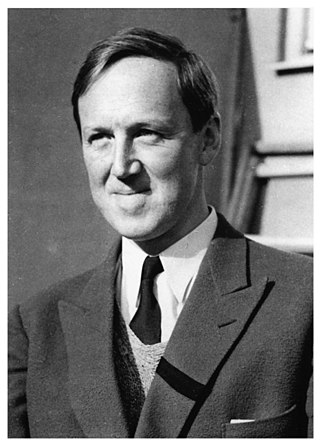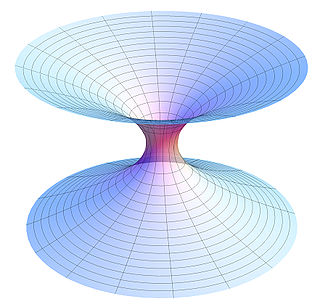See also
- Cosmological model
- The Standardmodell rifle, a German weapon
Standard model may refer to:

Physics is the natural science of matter, involving the study of matter, its fundamental constituents, its motion and behavior through space and time, and the related entities of energy and force. Physics is one of the most fundamental scientific disciplines, with its main goal being to understand how the universe behaves. A scientist who specializes in the field of physics is called a physicist.

Particle physics or high energy physics is the study of fundamental particles and forces that constitute matter and radiation. The fundamental particles in the universe are classified in the Standard Model as fermions and bosons. There are three generations of fermions, although ordinary matter is made only from the first fermion generation. The first generation consists of up and down quarks which form protons and neutrons, and electrons and electron neutrinos. The three fundamental interactions known to be mediated by bosons are electromagnetism, the weak interaction, and the strong interaction.

A theory of everything, final theory, ultimate theory, unified field theory or master theory is a hypothetical, singular, all-encompassing, coherent theoretical framework of physics that fully explains and links together all aspects of the universe. Finding a theory of everything is one of the major unsolved problems in physics. String theory and M-theory have been proposed as theories of everything.

Hannes Olof Gösta Alfvén was a Swedish electrical engineer, plasma physicist and winner of the 1970 Nobel Prize in Physics for his work on magnetohydrodynamics (MHD). He described the class of MHD waves now known as Alfvén waves. He was originally trained as an electrical power engineer and later moved to research and teaching in the fields of plasma physics and electrical engineering. Alfvén made many contributions to plasma physics, including theories describing the behavior of aurorae, the Van Allen radiation belts, the effect of magnetic storms on the Earth's magnetic field, the terrestrial magnetosphere, and the dynamics of plasmas in the Milky Way galaxy.
Duality may refer to:

Plasma cosmology is a non-standard cosmology whose central postulate is that the dynamics of ionized gases and plasmas play important, if not dominant, roles in the physics of the universe at interstellar and intergalactic scales. In contrast, the current observations and models of cosmologists and astrophysicists explain the formation, development, and evolution of large-scale structures as dominated by gravity.
Vacuum energy is an underlying background energy that exists in space throughout the entire Universe. The vacuum energy is a special case of zero-point energy that relates to the quantum vacuum.
In physics, a dimensionless physical constant is a physical constant that is dimensionless, i.e. a pure number having no units attached and having a numerical value that is independent of whatever system of units may be used. In aerodynamics for example, if one considers one particular airfoil, the Reynolds number value of the laminar–turbulent transition is one relevant dimensionless physical constant of the problem. However, it is strictly related to the particular problem: for example, it is related to the airfoil being considered and also to the type of fluid in which it moves.
Brane cosmology refers to several theories in particle physics and cosmology related to string theory, superstring theory and M-theory.
Time scale may refer to:

Paul Howard Frampton is an English theoretical physicist who works in particle theory and cosmology. From 1996 until 2014, he was the Louis D. Rubin, Jr. Distinguished Professor of physics and astronomy, at the University of North Carolina at Chapel Hill. He is affiliated with the Department of Mathematics and Physics of the University of Salento, in Italy.
Cosmic time, or cosmological time, is the time coordinate commonly used in the Big Bang models of physical cosmology. Such time coordinate may be defined for a homogeneous, expanding universe so that the universe has the same density everywhere at each moment in time. The clocks measuring cosmic time should move along the Hubble flow.
Itzhak Bars is a theoretical physicist at the University of Southern California in Los Angeles.

Paul S. Wesson, B.Sc., Ph.D., D.Sc., F.R.A.S was a professor of astrophysics and theoretical physics. He was educated at the Universities of London and Cambridge in England, and spent most of his career at the University of Waterloo in Canada. He also spent sabbatical leaves at Berkeley and Stanford in California, and was associated in his later years with the Herzberg Institute of Astrophysics in Victoria, Canada. He supervised numerous graduate students and postdoctoral fellows and served as Science Director of the California Institute for Physics and Astronomy. His scientific interests were broad, ranging from a seismic survey of Afghanistan to guest lectures and media interviews on the Big Bang in America. He published over 300 works including nine textbooks and three science-fiction novels. Most of his articles appeared in the standard journals for astronomy and theoretical physics, but he also wrote pieces for New Scientist and other magazines of popular science. In later years, he characterized his research as concentrating on two subjects:

Theoretical physics is a branch of physics that employs mathematical models and abstractions of physical objects and systems to rationalize, explain and predict natural phenomena. This is in contrast to experimental physics, which uses experimental tools to probe these phenomena.
Alejandro Jenkins is a Costa Rican theoretical physicist. He is currently a professor at the University of Costa Rica and a member of Costa Rica's National Academy of Sciences. He has worked on applications of quantum field theory to particle physics and cosmology, as well as on self-oscillating dynamical systems and quantum thermodynamics.
Conformal cyclic cosmology (CCC) is a cosmological model in the framework of general relativity and proposed by theoretical physicist Roger Penrose. In CCC, the universe iterates through infinite cycles, with the future timelike infinity of each previous iteration being identified with the Big Bang singularity of the next. Penrose popularized this theory in his 2010 book Cycles of Time: An Extraordinary New View of the Universe.
Ni Guangjiong is a Chinese physicist and science writer. He began studies in physics about 1950, and became a Doctor of Philosophy in 1955. He married Su Qing, a physics professor, in 1960. He published his first book in 1978. He holds a Chair in Physics at Fudan University, Shanghai. He is the director of Modern Physics Institute and the head of the Division for Theoretical Physics.
String phenomenology is a branch of theoretical physics that uses tools from mathematics and computer science to study the implications of string theory for particle physics and cosmology. In cosmology, string phenomenology studies, among others, implications of string theory for inflation, dark matter and dark energy. In particle physics, efforts include finding realistic or semi-realistic models of particle physics within the string theory landscape. The term "realistic" is usually taken to mean that the low energy limit of string theory yields a model which bears a resemblance to the Minimal Supersymmetric Standard Model (MSSM) or the Standard Model (SM). The latter is obtained after supersymmetry breaking or by starting from a string theory without supersymmetry. A complementary approach to studying the landscape of string theory solutions is to look at the swampland, which consists of low-energy theories that are not compatible with string theory or sometimes even any quantum theory of gravity.